Guide to Trial Brakes
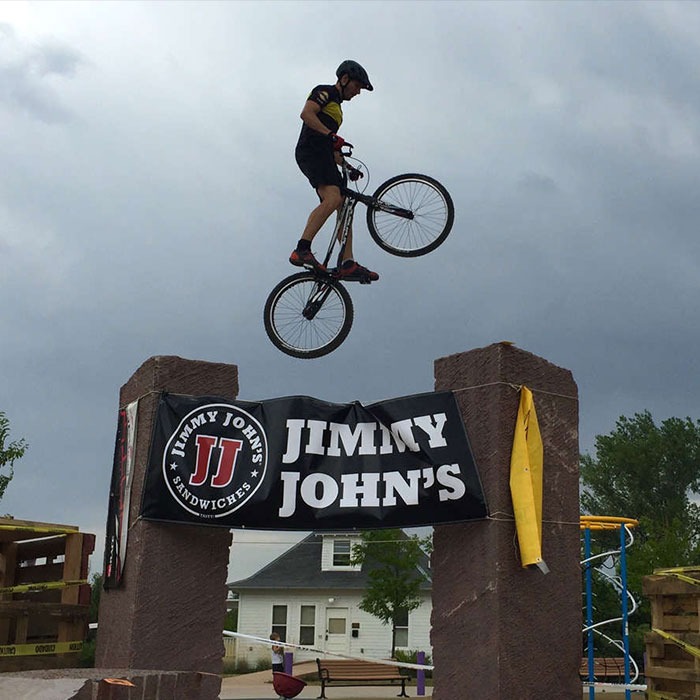
Author: Ross Winsor, Webcyclery pro trials rider and 5x US National Champion
Last updated: June 2023
Understanding brakes on a trial bike is integral to performance and the confidence riders have in riding all types of terrains and through obstacles. Learn about which trial bike brakes might be best for you.

Braking in Trial Bikes
Brakes are extremely important in trials because so many of the techniques and situations in trials require very powerful, reliable braking. Riders need to be able to be able to trust the brakes to hold the wheel in place on all types of terrain and obstacles. Riding trials without good brakes is frustrating at best and dangerous at worst. Cheap brakes tend not to be adequate for anything other than very basic trials moves, so it often pays to spend a bit more on powerful brakes on trials bikes.
In trials riding, more or less modulation can be desirable depending on the situation. Having more modulation is good for things like manuals when you really want to be able to apply just the right amount of braking power as your balance shifts back and forth. Having less modulation is good for many rear wheel moves when you are balancing on a small object and you want the brake to just stay fully locked so your wheel doesn’t slip. Generally, the more advanced the moves, techniques or obstacles are, the more powerful the brakes need to be.
Mechanical vs. Hydraulic Disc Brakes
Wondering what the differences are between mechanical and hydraulic brakes? Here is a quick rundown of the differences and pros and cons of each for trials riding.
Mechanical or cable brakes are a traditional type of brake that uses a simple cable pulled at the lever to actuate the pads at the caliper. They are typically simple, reliable and easy to maintain and adjust but they do tend to be heavier than hydraulic brakes. Compared to hydraulic brakes, they generally have a more on/off feel. In other words, they have less modulation and it is slightly harder to feather the brake. It is also easy to replace the cable if it gets damaged in a crash, which can be more of a concern in trials than with other cycling disciplines. One of their big advantages over hydraulic brakes is their relatively low cost.
Hydraulic brakes use brake fluid pushed by a piston in the lever to actuate the pads in the caliper. They are usually lighter and more expensive than mechanical brakes. They are typically also a reliable type of brake but the brake hoses can occasionally be damaged in crashes. Compared to mechanical brakes, they have more modulation so you can progressively apply the exact amount of power you need. Many high-end hydraulic disc brakes are more powerful than mechanical brakes. Most high level riders (both street trials and competition) use hydraulic brakes.
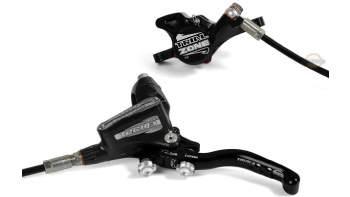
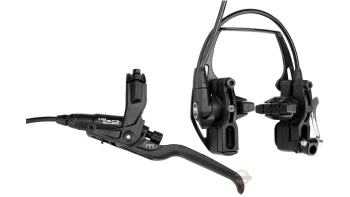
Disc Brakes vs. Rim Brakes
Another very common question is what type of brake is best for trials: disc or rim? In reality, neither one is best, each has advantages and disadvantages and it depends a lot on the riding style. Rim brakes, both hydraulic and vee, generally have a more on/off feel with not much in between. In other words, they have less modulation than disc brakes. This on/off braking is very desirable for many situations in trials when you need the wheel to be completely locked on an obstacle.
Disc brakes have a smoother, more progressive feel. They can be feathered to provide just the right amount of power where and when it’s needed. This is especially useful for moves such as manuals or nose wheelies. Some riders also prefer disc brakes because they’re relatively silent, whereas rim brakes generally make quite a bit of noise, particularly when used with a rim grind. Rim brakes are generally lighter than disc brakes, and this is one of the reasons they’re prevalent on many competition bikes. Rim brakes also have the advantage of not having a rotor that can be hit and damaged, which can occasionally happen with trials riding and disc brakes.
Trials bikes can also use a combination of rim and disc brakes in a variety of configurations. One possible setup on some trials bikes is to have a front disc brake and a rear rim brake. This gives the rider excellent locking power for the rear wheel and the ability to slow down and modulate using the front brake. As a result, this can be a good option for beginners who are still learning the basics. Dual disc brakes are common on 20” bikes because the smaller wheels can be locked up easier with standard size rotors. Many competition style 20” bikes will also use a rear disc with a front rim brake.
This combination allows precise control on the rear wheel and lighter weight on the front end of the bike, as well less spoke flex, which is beneficial for many advanced moves like hooks and front wheel moves. Dual rim brake is a common setup found on 26” competition style bikes. The rim brakes are lighter than the large disc rotors that would be needed for the larger wheels and they also eliminate the spoke flex that occurs with disc brakes in trials. Disc brakes are also nearly ubiquitous nowadays on street trials bikes of all wheel sizes where having modulation is more beneficial.
Popular Trial Bike Brake Options
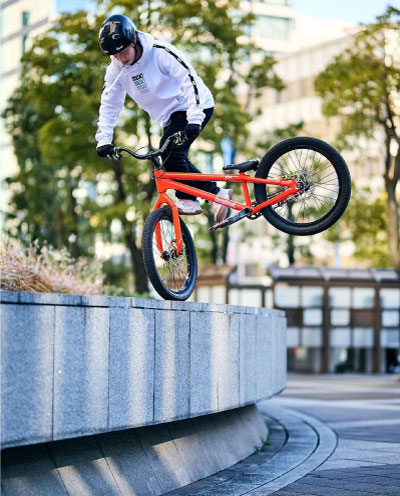
Disc Brakes
Very few companies make trials-specific disc brakes. However, many more powerful 4-piston disc brakes from well-known mountain bike brands like Shimano, Sram, Hope, Magura and others can work well for trials. We don’t typically recommend two piston disc brakes for trials (with the exception of the Hope Tech Trial brakes) because they tend to just not have the bite and power needed for trials riding.
Hope and Magura are two of the brands most commonly spec’d on complete trials bikes. They each produce some excellent disc brakes for trials.
Hope offers the Tech Trial disc brake, which is one of the only disc brakes on the market designed specifically for trials. Unlike most other high end trials-worthy brakes, it uses only two pistons. However, the pistons are much larger than normal, giving the brake excellent power for locking the wheel. It is manufactured by Hope in the U.K., with the lever body and caliper being machined from a solid block of aluminum. This makes them slightly heavier than other brakes but very solid and durable, as well as being harder to damage in crashes. The only real disadvantage of the Hope Tech Trial brakes is that they are designed for trials only, they are not suitable for mountain biking, so they are not as versatile for other applications.
Magura’s top end MT7 disc brake is made for World Cup downhill courses but that power also translates well for trials use. It uses 4 pistons, giving it excellent power but also good modulation. Manufactured in Germany, it features an aluminum caliper and proprietary Carbotecture lever, making it one of the lighter 4 piston disc brakes out there. Being a mountain bike brake, it can of course also be used on mountain bikes or dirt jump bikes, giving it added versatility.
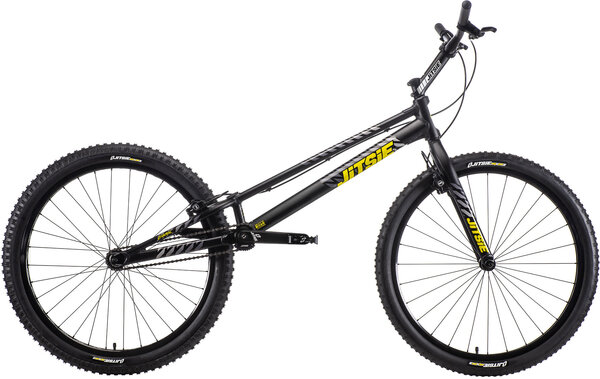
Rim Brakes
Hydraulic rim brakes are also a common sight on trials bikes. Although increasingly rare in other applications, they are an excellent option for competition style trials bikes. They have very little modulation but have a very solid engagement to lock up the wheel. Because of this property, they are increasingly rare on street trials bikes where at least some modulation is usually desirable.
Mechanical V-brakes are another less common brake setup in trials. With a few exceptions, there are very few frames or forks manufactured nowadays with v-brake posts. If your frame or fork does have v-brake mounts however, a well set-up v-brake can deliver excellent locking power. High quality cables and housing (especially compressionless housing) are a must for v-brakes to perform properly for trials.
Aftermarket Trials Brake Pads
Many trials companies also offer trials-specific aftermarket brake pads for their own brakes as well as other manufacturers. Trials-specific pads will almost always have better performance for trials than the standard brake pads that come with a brake (disc or rim).
For disc brakes, Jitsie and Trialtech offer aftermarket pads for a wide variety of brakes. These pads use a special metallic compound that is more powerful and has better bite than standard compounds. These properties do make them unsuitable for other types of riding like mountain biking though, so we only recommend them for trials use.
Many trials companies also produce aftermarket pads for trials rim brakes. Some of the popular brands we carry include Kool-Stop, Jitsie and TNN. There are two main types of trials rim brake pads, the difference between the two being what material the pad backing is made out of. The first type uses a standard plastic backing that is lightweight and affordable. The second type uses an aluminum backing that is stiffer but more expensive. The stiffer backing gives a slightly more firm lever feel and increased power.
